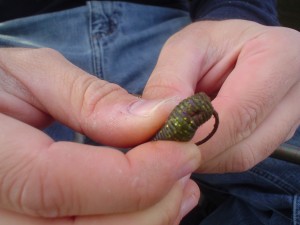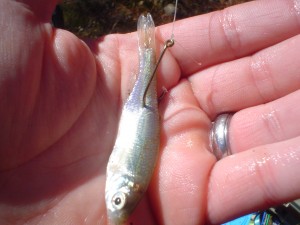Types of Fishing Bait
Depending what fish you are currently trying to catch will determine the bait you should use. If you plan on Bluegill Fishing then you may want to consider using worms or night crawlers. If you are seeking out a larger predator like Bass or Pike, then you should consider using a shiner or sucker. Catfish Fishing requires using either a dead fish, or a chunk of a fish which is rigged a bit differently than if you were to be fishing for Bass or Trout. So your first step is to decide what fish your plan on fishing for.
Adding Worms to a Fishing Hook

Worms can be applied to a hook using a few different methods. The first method is simply to thread the worm onto the hook. This can be achieved by holding the worm with your right hand and the hook in your left. Take the point of the hook and insert it into one end of the worm and then slide the worm’s body over the hook until it is completely covered by the worms body. Another way of describing this method is simply to send the hook lengthwise through the body of the worm. This is probably the most common method of adding a worm to a hook.
Another method is to wrap the worm onto the hook. This method requires your to take the point of the hook and send it through one side of the worm and then to come out the other site. This process is repeated until the entire shaft of the hook is filled with the body of the worm. This is the less preferable method as it uses more worm and increases the chances of it being nibbled off by a Perch or Bluegill. It is effective however and fish can be caught this way.
Attaching Shiners to a Fishing Hook

Shiners or suckers can be applied to a fishing hook in a variety of methods. The most popular method is to take the point of the hook and send it through the upper region of the tail of the shiner. This will allow the shiner to swim freely as well as expose the hook in the correct direction if a Bass or other fish swallows the shiner head first. It is important to direct the sharp point towards the tail of the fish as Bass and other species generally eat the shiner head first. If you notice Bluegills, Perch and other species of fish have sharp needle like spines that protrude from their dorsal fins. This helps them from being eaten from behind from a predator. The larger predators know this fact and will eat a majority of their prey head first for this reason.
Applying Small Insects to a Fishing Hook
Small insects can also be used as bait for a variety of fish species. To name a few Trout, Bass, Pike, Bluegill, Crappie and Perch can all be caught using small Insects. Some insects to consider as bait would be Beatles, large ants, dragon flies and crickets. When you hook a small insect you want it to stay alive as long as possible so try to hook it in a region that will cause minimal damage to the body of the insect. With a Dragonfly, Cricket or Beatle you can hook them through a wing. It is very difficult to hook and ant without damaging it in some way, but through the lower abdomen is the easiest place to hook an ant.

